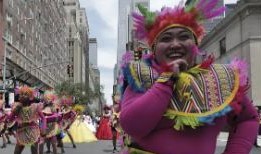New York, June 12: In the Philippines — where Spanish and later U.S. colonial rule persisted for nearly four centuries — June 12 is the real Independence Day. That date in 1898 was the pivotal moment when the island nation first made a bold move for autonomy.
Ahead of this year’s holiday in Manila, the nation’s capital, President Ferdinand Marcos Jr. called on Filipinos in a video message to display the country’s flag everywhere “as we continue to fight for independence. Independence in different aspects of our being Filipinos, but more than this independence in our territory, our sovereignty.”
Since 2023, the Philippines has faced increasingly tense territorial confrontations with Beijing in the South China Sea.
The much-awaited annual celebration would be festive with an array of activities, which started Monday at the capital’s historic Rizal Park, Marcos said. There’s a bazaar along with government stalls offering services to the public. The festivities include a cooking competition, a chili pepper-eating contest, free showing of movies about Filipino heroes, free nightly concerts and an obstacle-course race. A parade of 22 floats representing different provinces will be staged on Independence Day to be capped by a musical concert, he said.
The revelry surrounding Philippine Independence Day stretches far beyond the Southeast Asia archipelago, from the United Kingdom to the United Arab Emirates. Millions of Filipinos across cities in the U.S., Europe and Australia will be able to find parades, street fairs, galas and other gatherings close to home. Some are even flying in well-known talent from the Philippines. The occasion’s growing reach and inclusive ethos demonstrate how much the Filipino diaspora continues to assert cultural pride and flourish around the globe.
The fight for independence dates back to 1565 when Spain colonized the Philippines, naming it for King Philip II. It wasn’t until 1896 though that talk of revolution catalysed action. Andrés Bonifacio, a leader of the Katipunan, a brotherhood of anti-Spain revolutionaries, and others tore up their “cedulas,” residential tax certificates for people considered Spanish subjects.
“It’s like tearing your passport or whatever identifies you as a citizen of a nation,” said Richard Chu, a history professor at the University of Massachusetts Amherst who was born in the Philippines. “So, they tore that up symbolically as a break and declared independence — or at least (were) fighting for independence from Spain.”
Emilio Aguinaldo, also a member of the Katipunan, saw an opportunity for liberation when the U.S. declared war on Spain on April 25, 1898, over its treatment of Cuba. On June 12, he proclaimed independence and a year later, even became the first president of the Philippine Republic. But, the U.S. refused to recognize the country as a stand-alone territory, igniting the Philippine-American War, which lasted until April 1902.
The Philippines finally became independent on July 4, 1946. So, the Fourth of July was the traditional holiday until President Diosdado Macapagal changed it in 1964 to June 12.
As a child in the ’70s, Chu remembers watching preparations in Rizal Park. Festivities started in the morning with the senior Marcos raising the flag as cabinet and military officers looked on. The parade was more of a “military parade followed by people from different government agencies.”
“It’s supposed to be a festive celebration and every other city or major town would have its own Independence Day celebrations,” Chu said.
Independence Day may evoke mixed feelings for some who don’t have the same nationalist fervour or agree with its government’s policies. This is one reason Chu doesn’t feel an urgent need to mark the holiday. At the same time, he likes being with other Filipinos in his community.
“If I lived in Boston, I probably would participate just because of the festivities, like the food vendors and maybe some popular Filipino American scenery,” Chu said. “I am proud to be Filipino for sure.”
Festivities in the U.S.New York City held a parade and a street fair along Madison Avenue on June 2. The same weekend in Seattle there was a two-day Pagdiriwang Philippine Festival. There have been large fiestas and smaller picnics in Texas, California and Colorado, among other states.
In Phoenix, the Arizona Diamondbacks baseball team is holding its first-ever Filipino Heritage Celebration at Tuesday’s game against the Los Angeles Angels. (AP)



COMMENTS